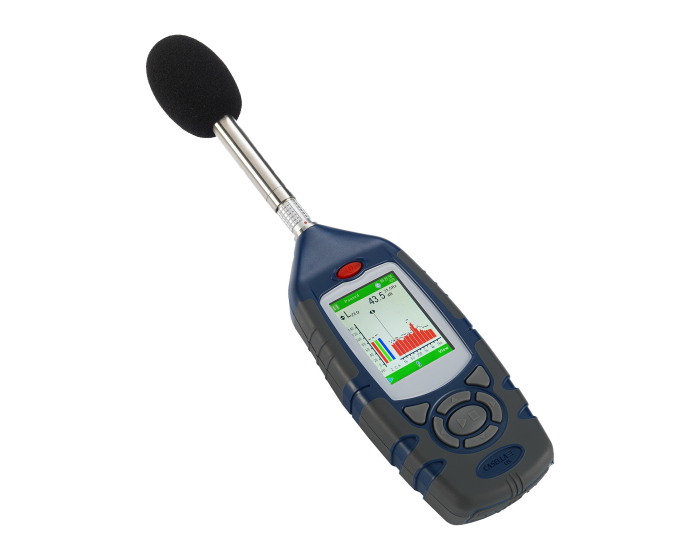Sound level meters are popular tools for a range of applications and industries. If you already have a sound level meter or have been looking for one, you have likely come across the terms Class 1 or Class 2. In this article, we will explain the difference between the two meters and give some excellent examples of both types of meter.
About Sound Level Meters
Sound level meters are devices used for acoustic measurements of music, noise, or other sounds. They are generally small, handheld instruments that consist of a microphone for picking up sound and converting it to an electrical signal, signal processing circuitry and a display.
Class 1 vs. Class 2
When searching for the right sound level meter for a specific application, an essential attribute to consider is its Class. The Class of a sound level meter describes the accuracy as defined by the relevant international standards. In brief, Class 1 is more accurate than Class 2.
Type? Class? What’s the difference?
When searching for sound level meters, you will devices referred to either Class 1 or 2, type 1 or 2 or some brands may use these terms interchangeably. The definition of ‘types’ for sound level meters comes from the international standard IEC 60651. This standard has since been superseded by the IEC 61672 which groups meters into Class 1 or 2.
Both these standards have similarities and are roughly equivalent; however, the IEC 61672 that defines Class is a more modern standard that better details the demands on the meter, including performance, accuracy and calibration.
The below table from IEC 61672 sets out the different tolerance ranges permissible at different reference frequencies.

Table 1: Breaks down the tolerance limits of Class 1 and Class 2 meters at four reference limits (from IEC61672-1:2013)
What Class of meter do you need?
For the most part, the type of meter that you need will depend on your specific need or application, as well as any regulations that you are required to meet. Typically, a Class 2 meter will be satisfactory when assessing basic sound level in standard commercial, educational, recreational, industrial or residential applications. Where precision is critical, such as in laboratory environments, a Class 1 meter is recommended.
Product Examples
The Instrument Choice Scientists have assembled some product examples of both Class 1 and Class 1 sound level meters outlining their key specifications and functions.
Class 1 Sound Level Meters
Logging Environmental Sound Level Meter Class
Product Code: CEL-633A1-K1
With advanced functionality and a simple user interface, the CEL-633A1-K1 makes precise noise measurements as quick and straightforward as possible. The displayed information can be made as simple or comprehensive as required, and all measurement parameters are stored simultaneously so that no incorrect measurements occur.
CEL-633A1-K1 Specifications:
Measurement Range: 20-140dB
Accuracy: Class 1
Resolution: 0.1dB
Other Functions: Preconfigured setups for occupational and environmental measurements, data markers, back erase function, audio recording and, level triggered events for transient measurements.
Type 1 Sound Level Meter and Data Logger
Product Code: IC-SL4033SD
The IC-SL4033SD is an easy and innovative Type 1, Class 1 sound meter that comes with a two-point traceable calibration certificate and utilises an SD card to store sound level results. After taking the desired reading with the meter, pull out the SD card and plug it into the computer then download your measurements; no extra software or cables are required.
IC-SL4033SD Specifications:
Measurement Range: 30-130 dB
Accuracy: Type 1
Resolution: 0.1dB
Other Functions: dB ( A & C frequency weighting ), Time weighting, Peak hold, Data hold, Record and, auto range, and manual range selection options.
Class 2 Sound Level Meter Examples

Handheld Digital Sound Level Meter
Product Code: C-DSM1
The C-DSM-1 is a low cost, compact, and multiuse Class 2 sound level meter. This portable meter is recommended for measurements on the go. Additionally, the handheld unit includes a thread so it can be easily attached to a tripod.
C-DSM-1 Specifications:
Measurement Range: 30 to 130dB
Accuracy: Class 2
Resolution: 0.1dB
Other Functions: Data hold function, minimum and maximum memory function, and the utilisation of both ‘A’ and ‘C’ weightings to provide the typical response of the human ear.
Sound Level Meter and Datalogger
Product Code: IC-CENTER323
The IC-CENTER323 is a durable and accurate Class 2 sound level meter with a data logging function capable of storing up to 64,000 records. Further, this meter has a USB interface and compatible windows software so you can easily collect, graph, store and share your accumulated sound and noise data.
IC-CENTER323 Specifications:
Measurement Range: 30-130dB
Accuracy: Class 2 ±1.4 dB ( reference 94 dB@1KHz )
Resolution: 0.1dB
Other Functions: 60dB dynamic space in each range, time weighing fast/slow and minimum and maximum function
Conclusion
The Class of sound level meter you need will depend on the regulations set out either by government or other regulatory bodies with oversight of the particular task at hand. Understanding the two main types of sound level meters is a fantastic place to start.
Want more information on any of the products above? Need a bit of help finding the best meter for your application? Contact one of the Instrument Choice Scientists. We’re here to help!
Call 1300 737 871 or email customer-service@instrumentchoice.com.au.



